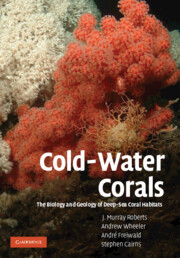7 - Corals as archives
Published online by Cambridge University Press: 23 December 2009
Summary
Corals are diaries that record within their pages many types of environmental information …
Geochemistry of corals: proxies of past ocean chemistry, ocean circulation, and climate Ellen R. M. Druffel (1997)Viewed from space the oceans dominate the surface of the Earth – as Arthur C. Clarke once noted, ‘How inappropriate to call this planet Earth when it is quite clearly Ocean.’ In terms of climate, the oceans are the Earth's major heat storage and transport system. For example, the first three metres of the oceans alone have an equivalent heat capacity to the Earth's entire atmosphere. Ultimately it is the oceans that exert the strongest control over planetary climate change and so perhaps it is not surprising that the clues to past climate change and the symptoms of future climate change can be found in the ocean record. Palaeoceanographers have reconstructed past climatic conditions using marine temperature proxies recorded in diverse sources ranging from foraminiferal tests in deep-sea sediments to annually banded shallow-water tropical corals. For example, oxygen isotope records from shallow, warm-water corals have revealed a recent, long-term warming and/or freshening throughout tropical regions (see review by Grottoli & Eakin, 2007). As predicted by Druffel (1997), cold-water corals are now emerging as a key archive of intermediate water-mass history. Unlike sediment-based foraminiferal records, which can be disrupted by the sediment mixing activity of infauna (bioturbation), coral skeletons offer continuous, high-resolution archives. Unlike tropical corals they are not restricted to the shallow, euphotic zone at tropical latitudes.
- Type
- Chapter
- Information
- Cold-Water CoralsThe Biology and Geology of Deep-Sea Coral Habitats, pp. 210 - 236Publisher: Cambridge University PressPrint publication year: 2009



